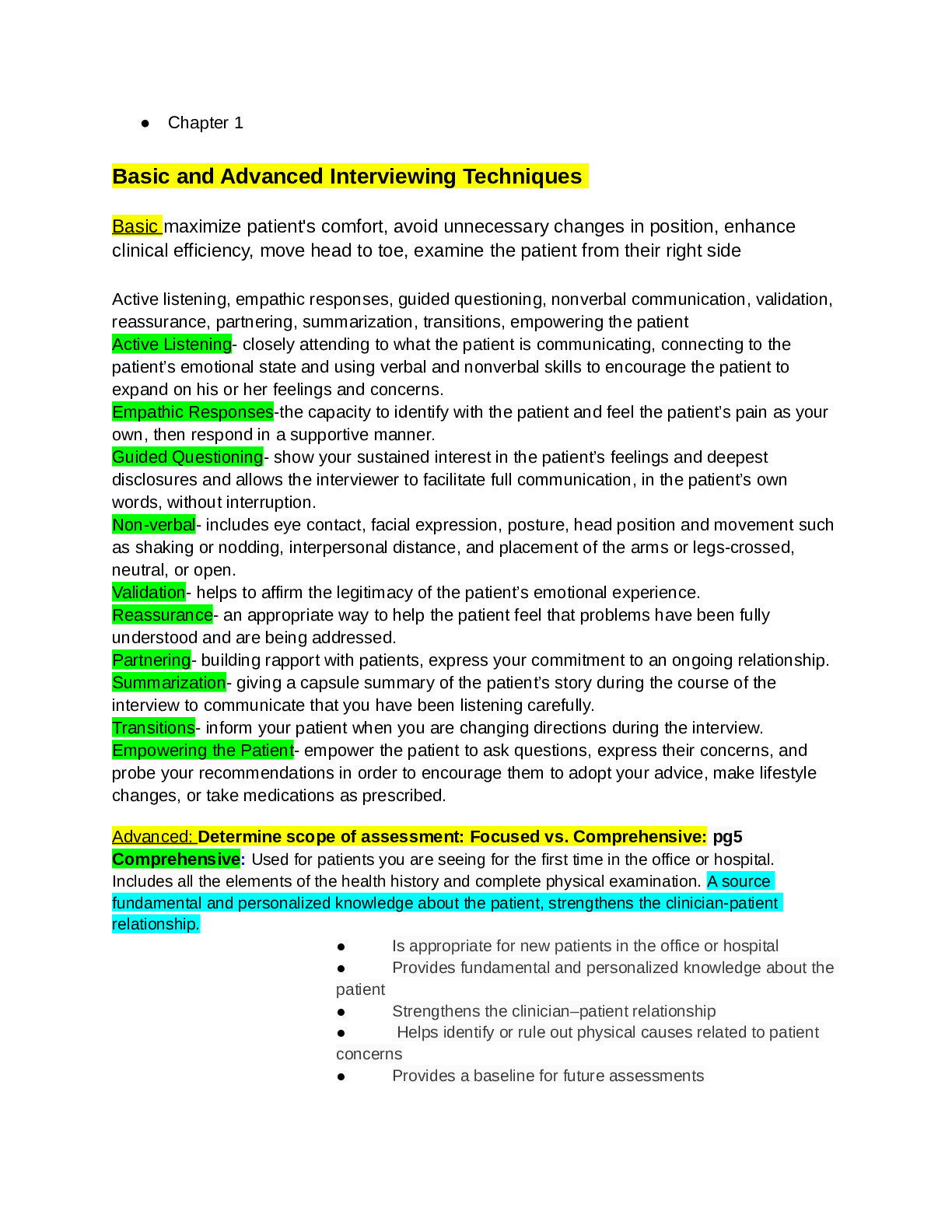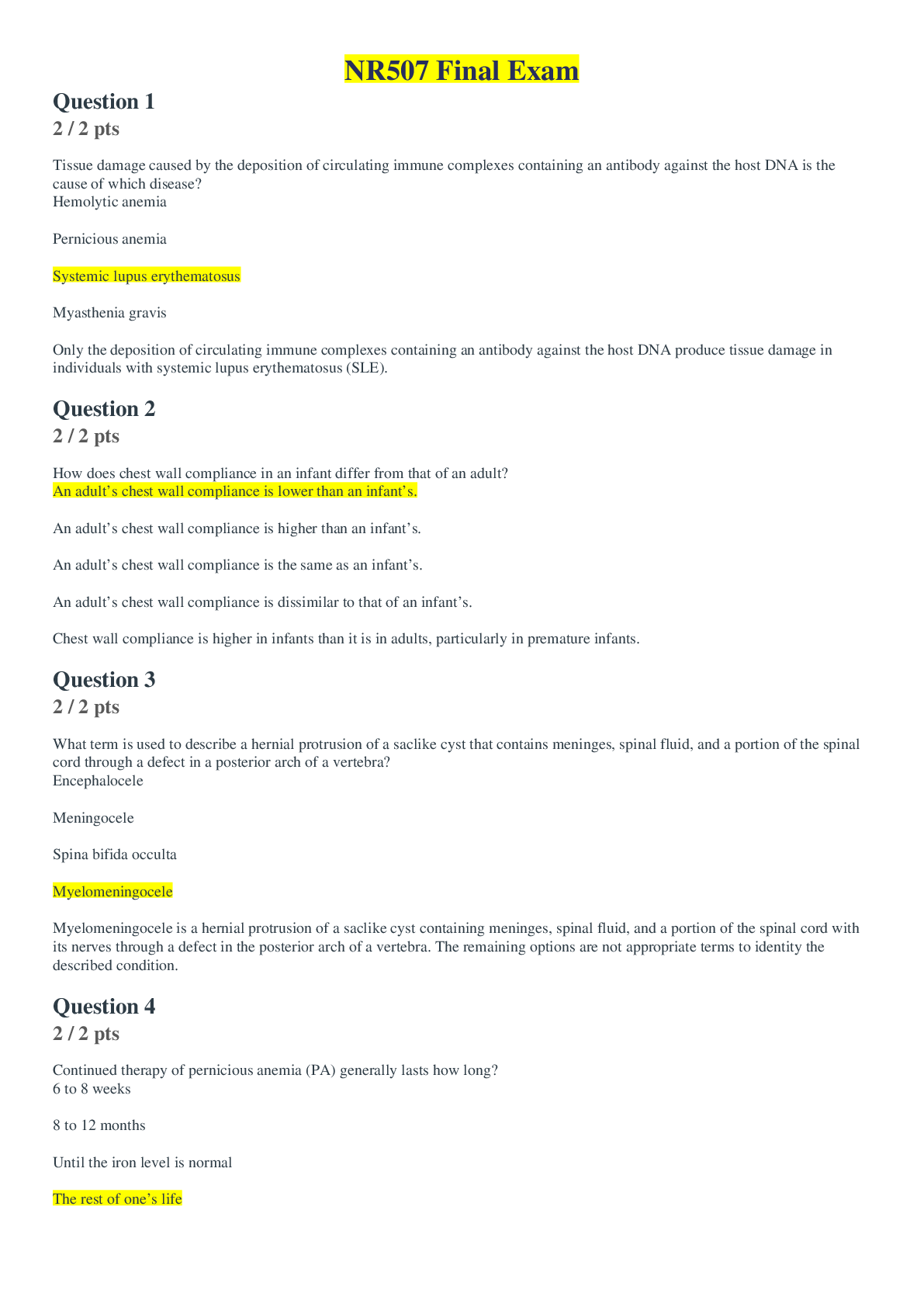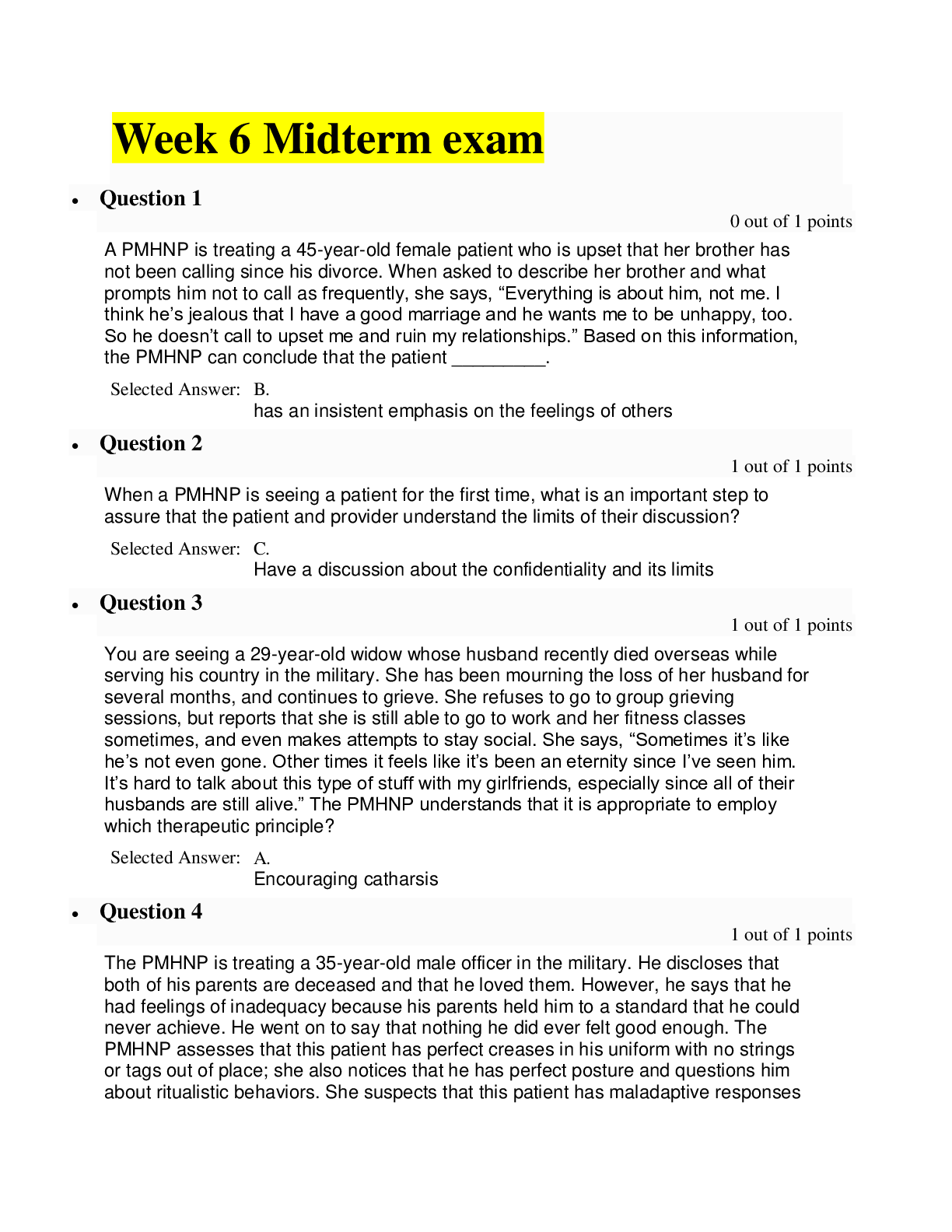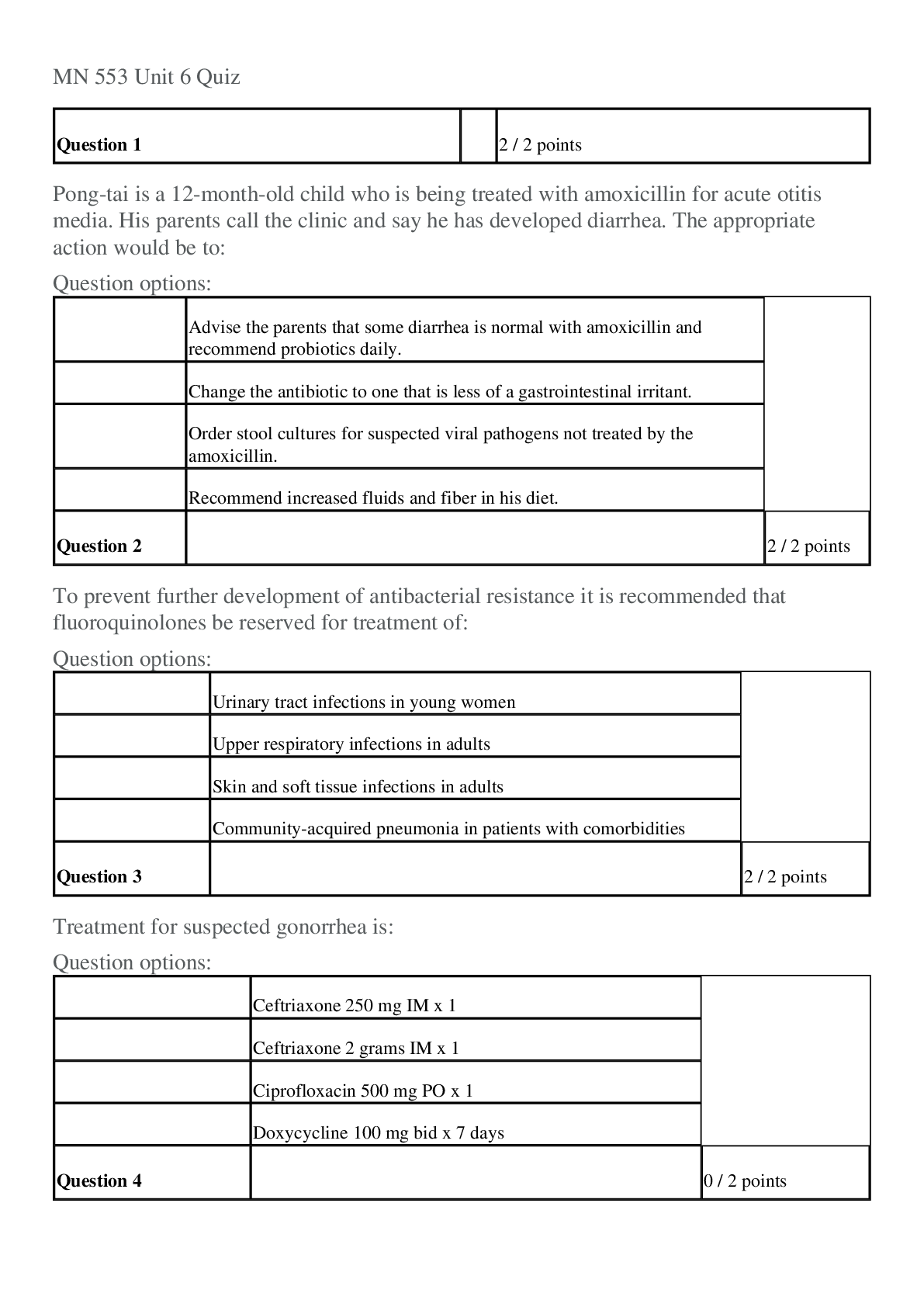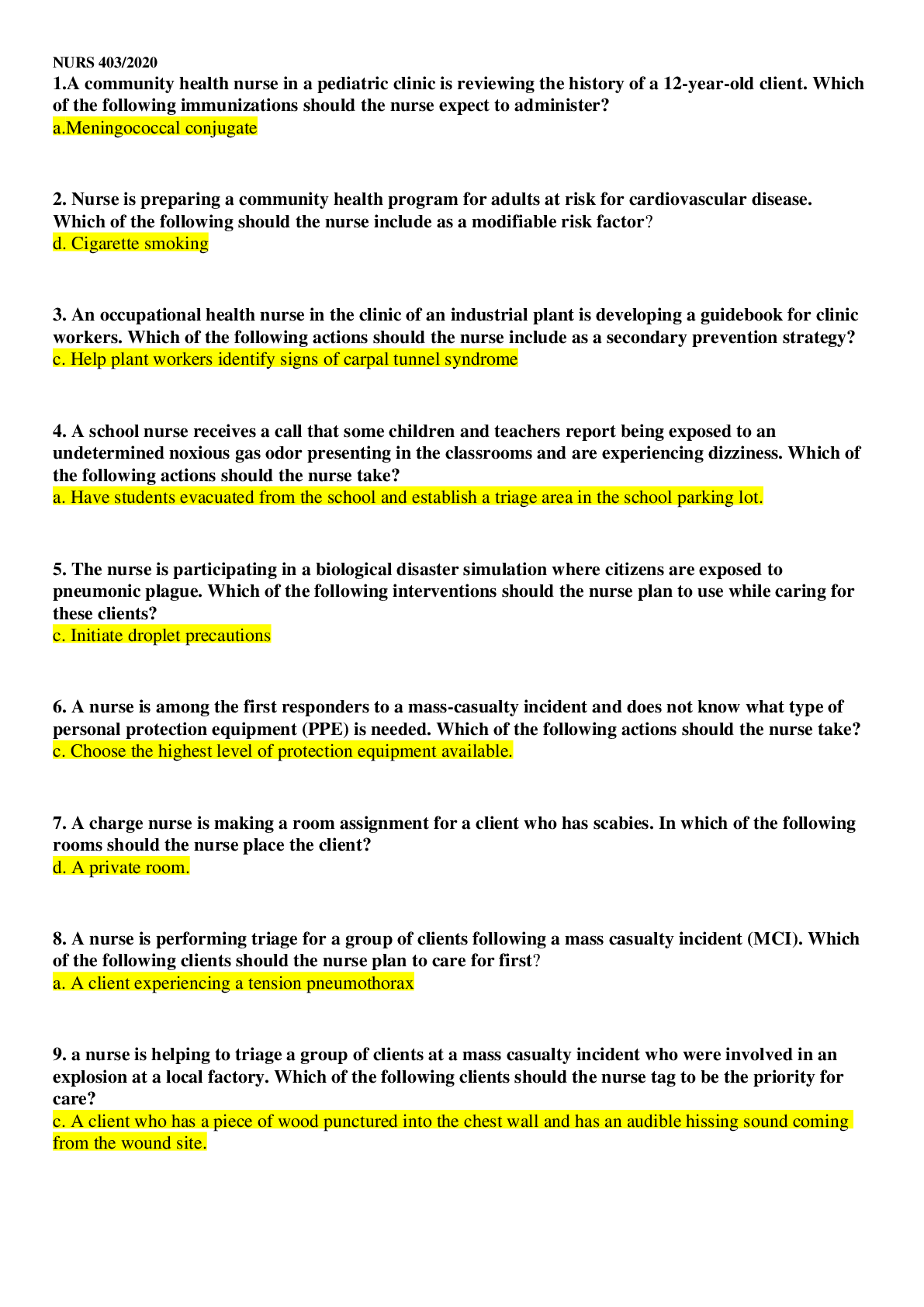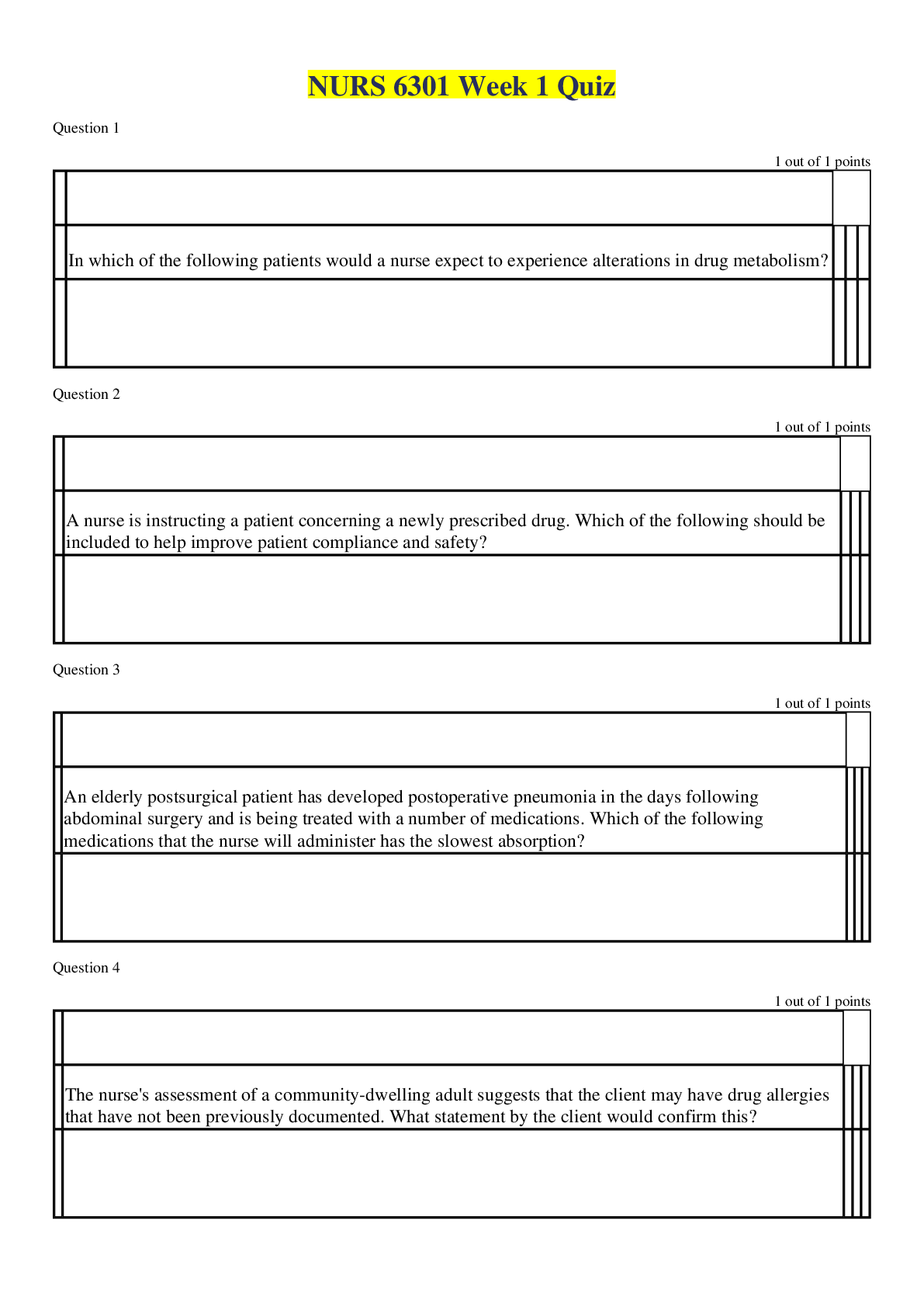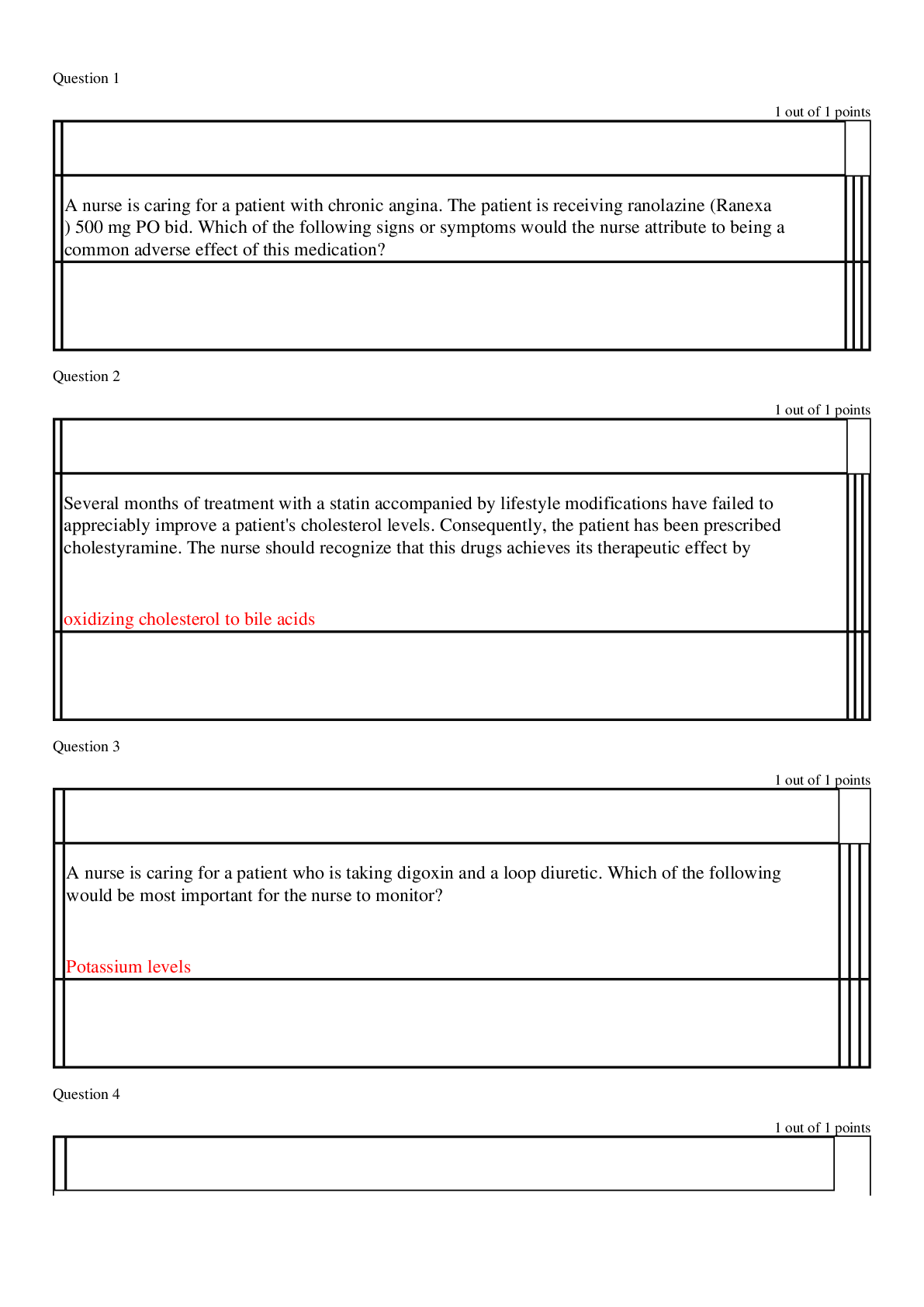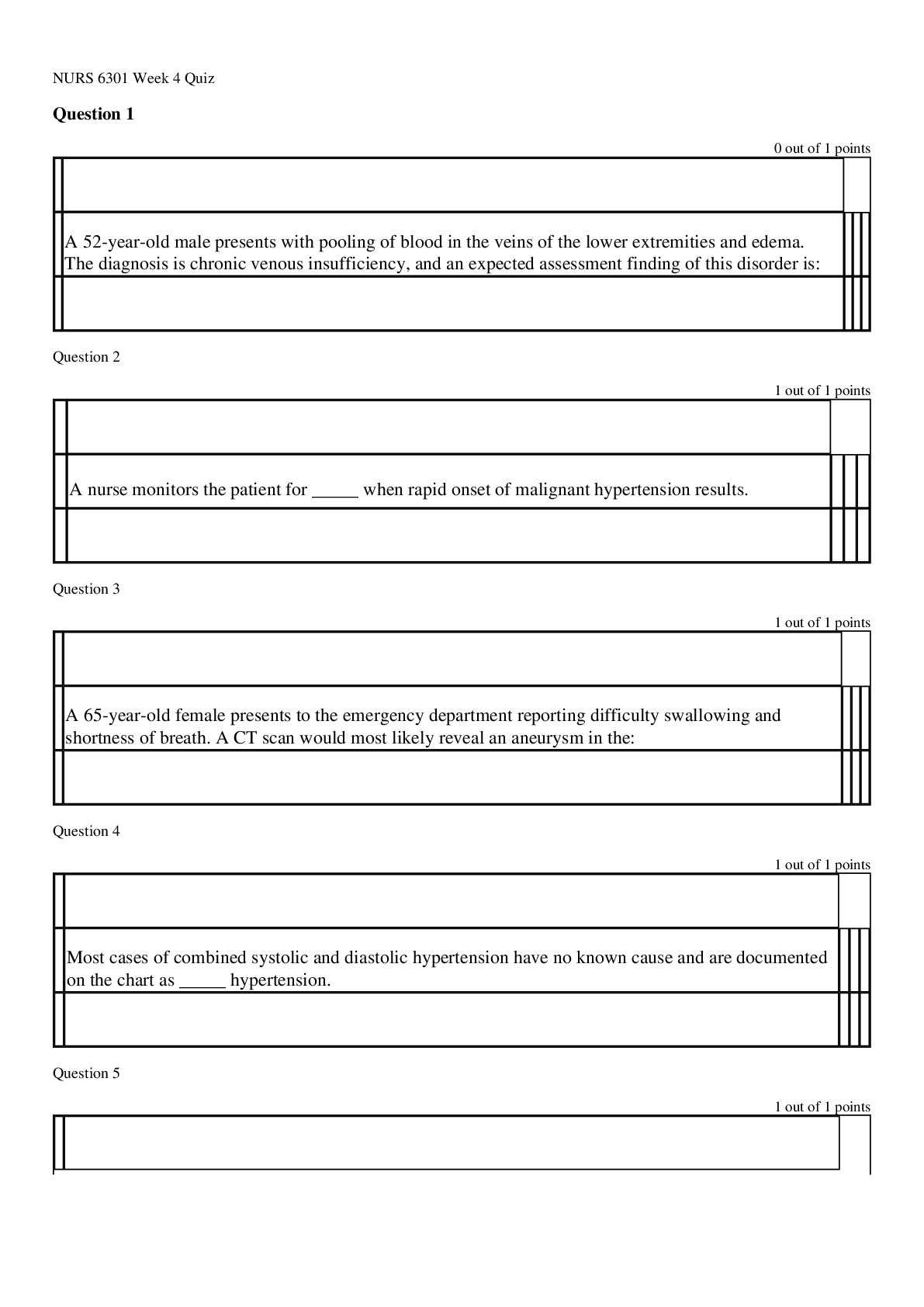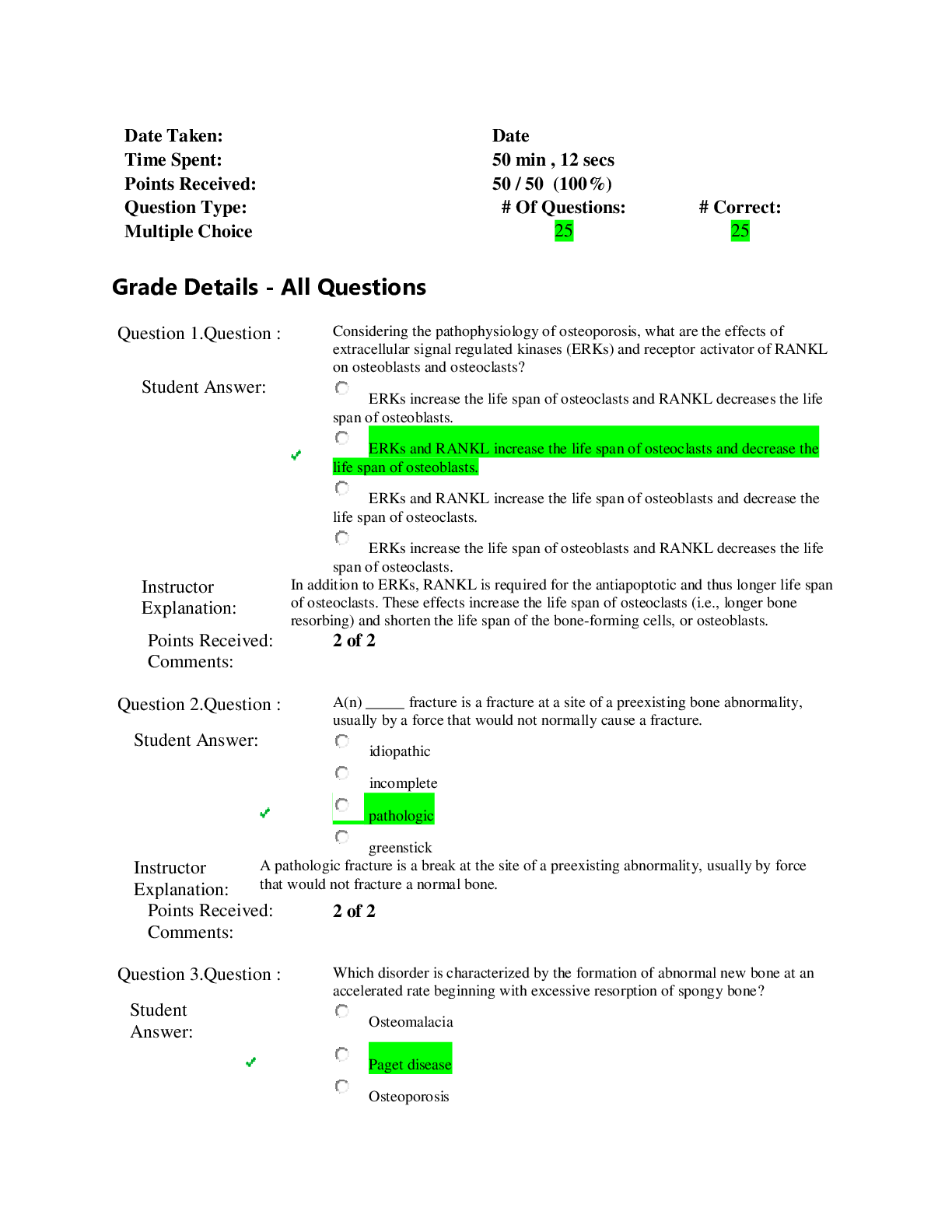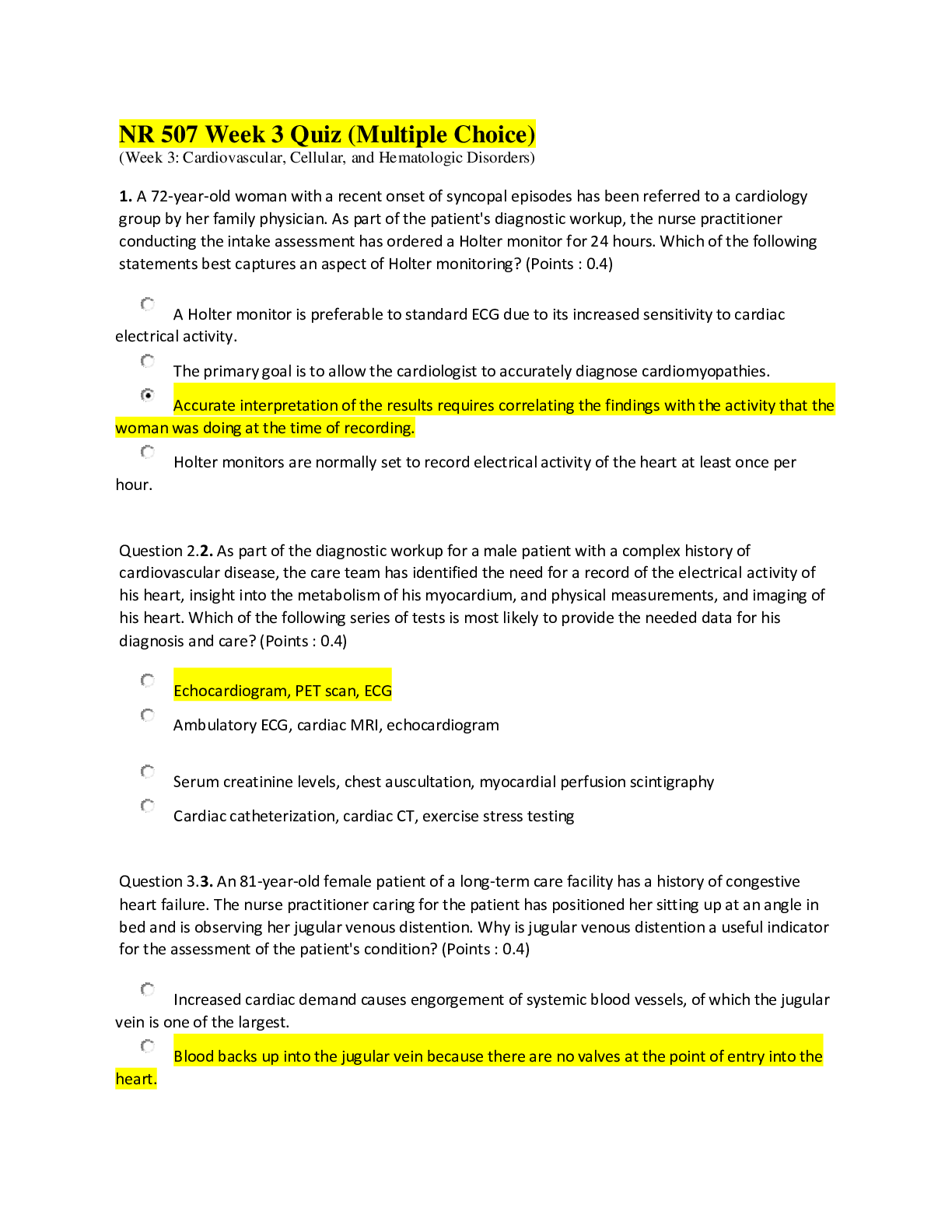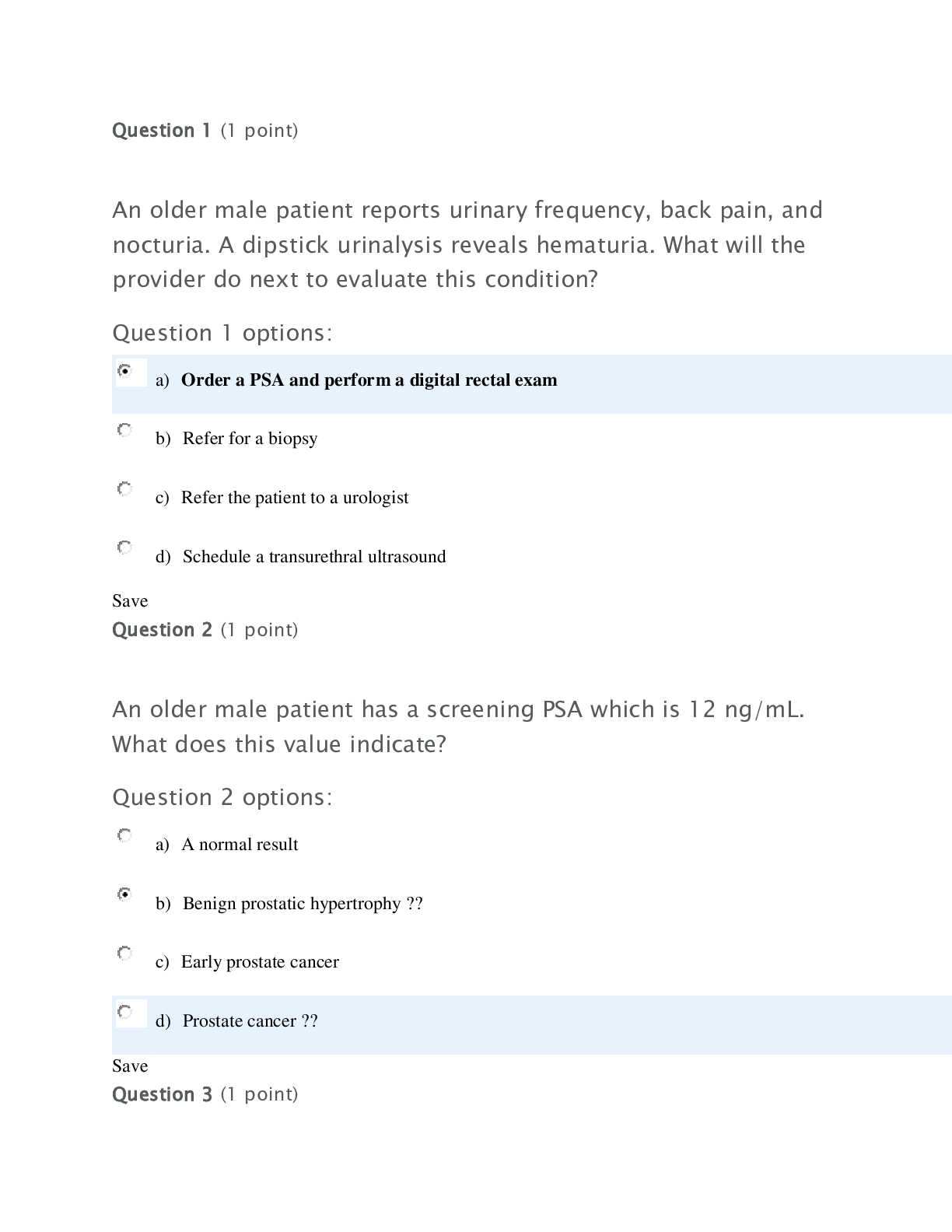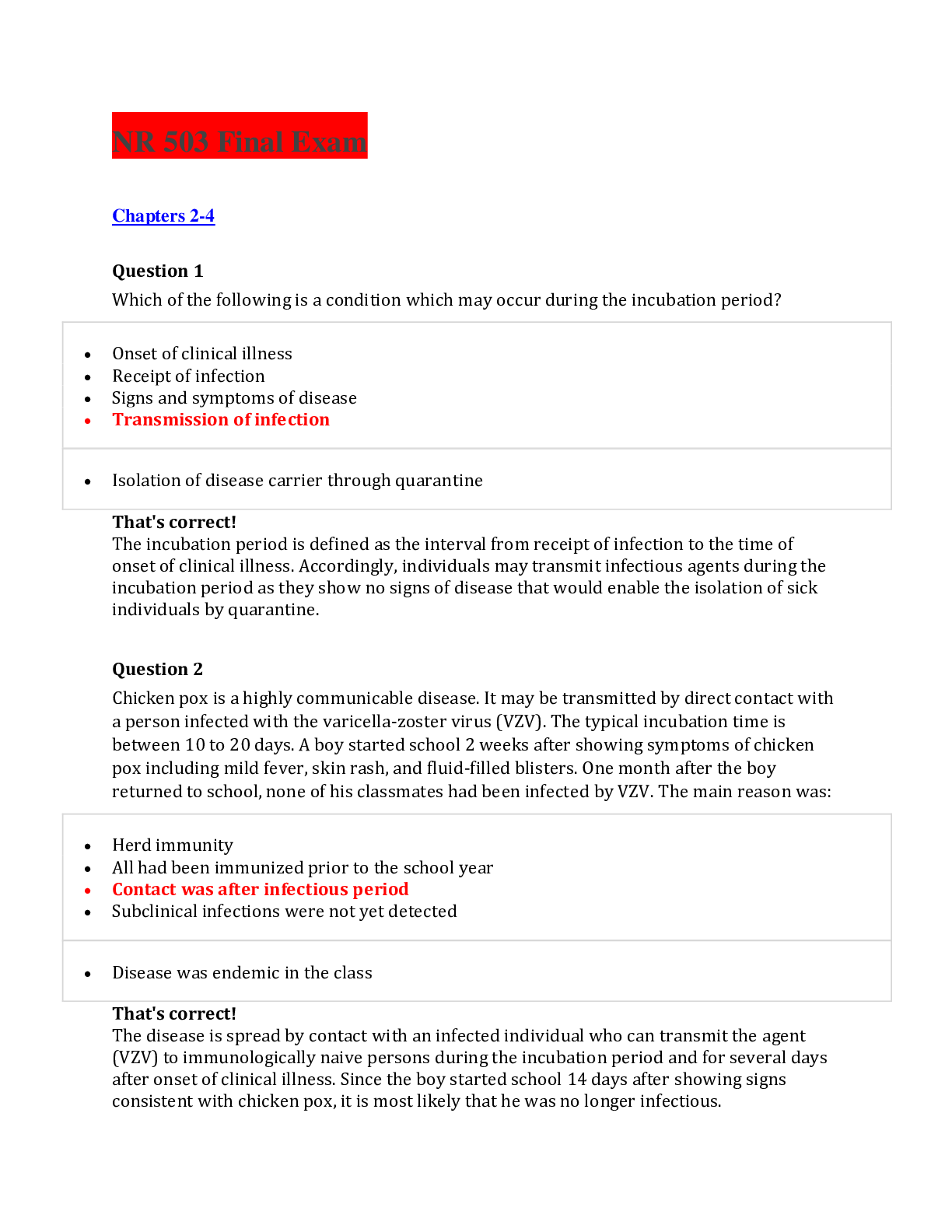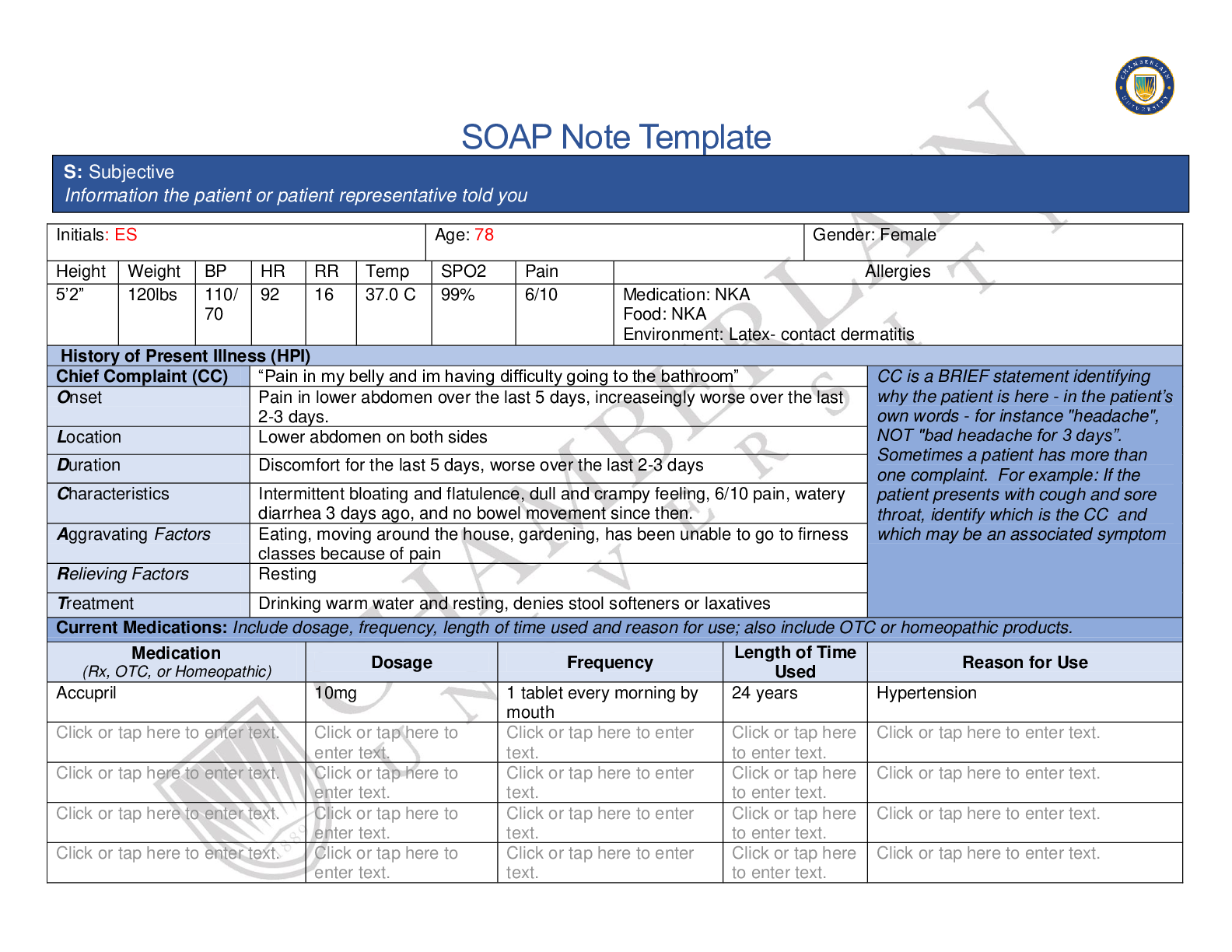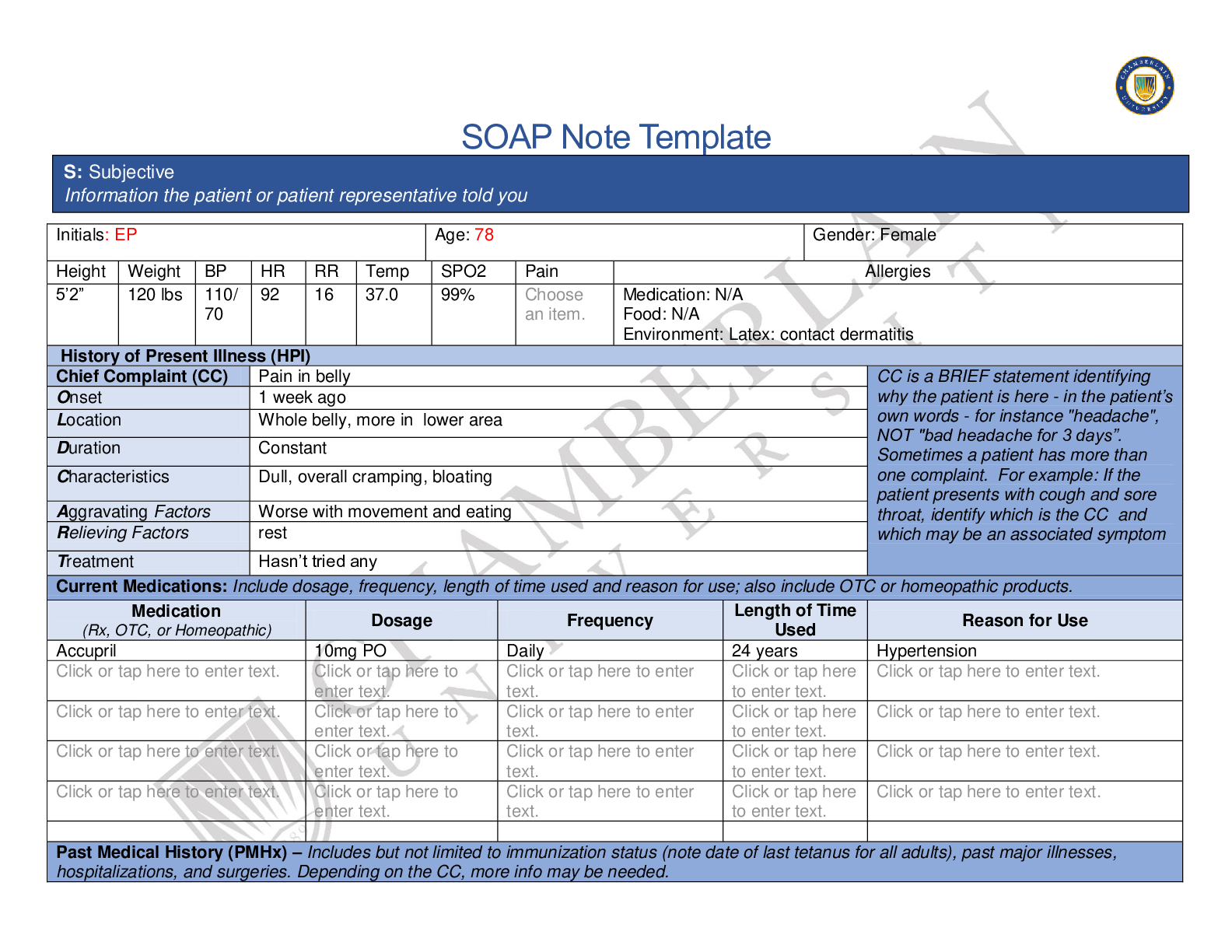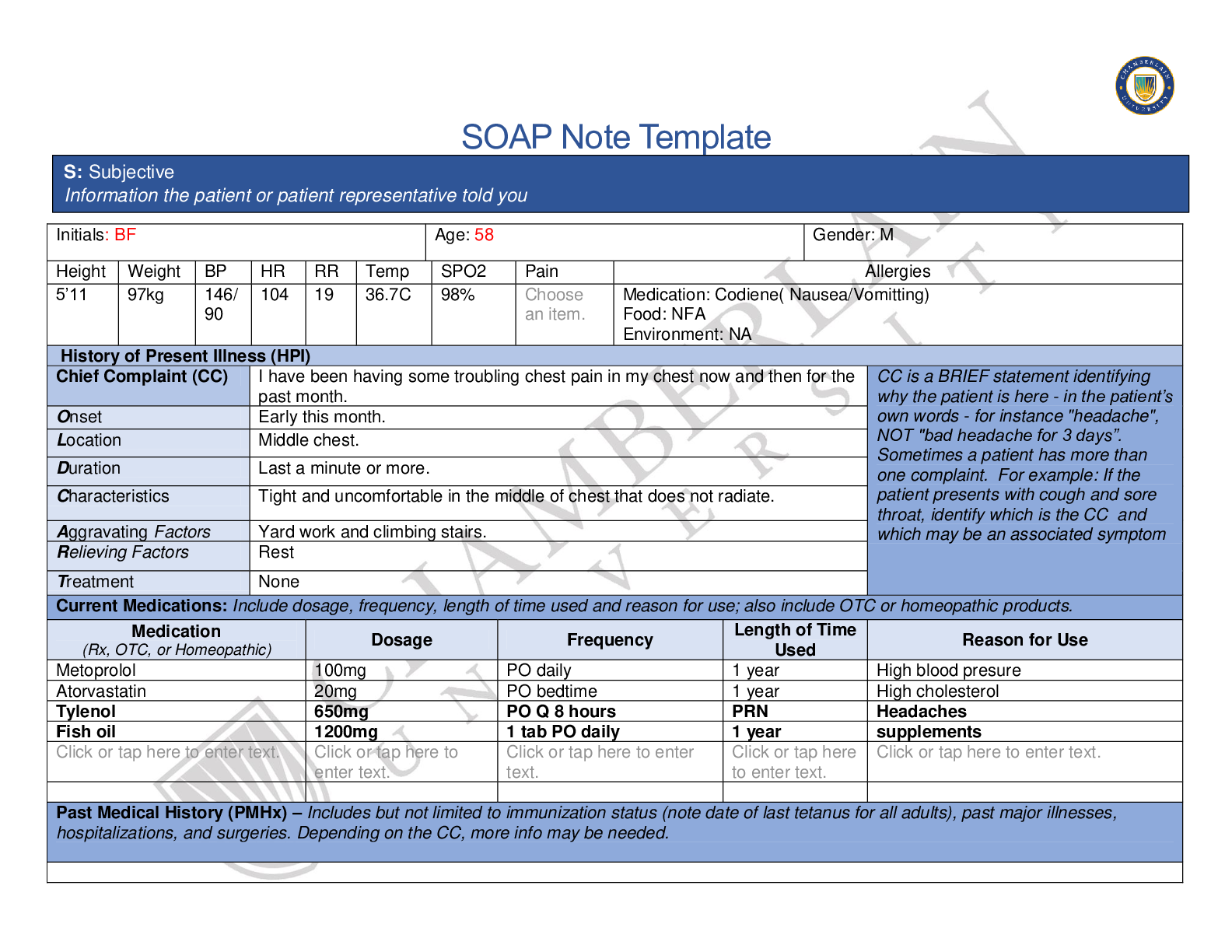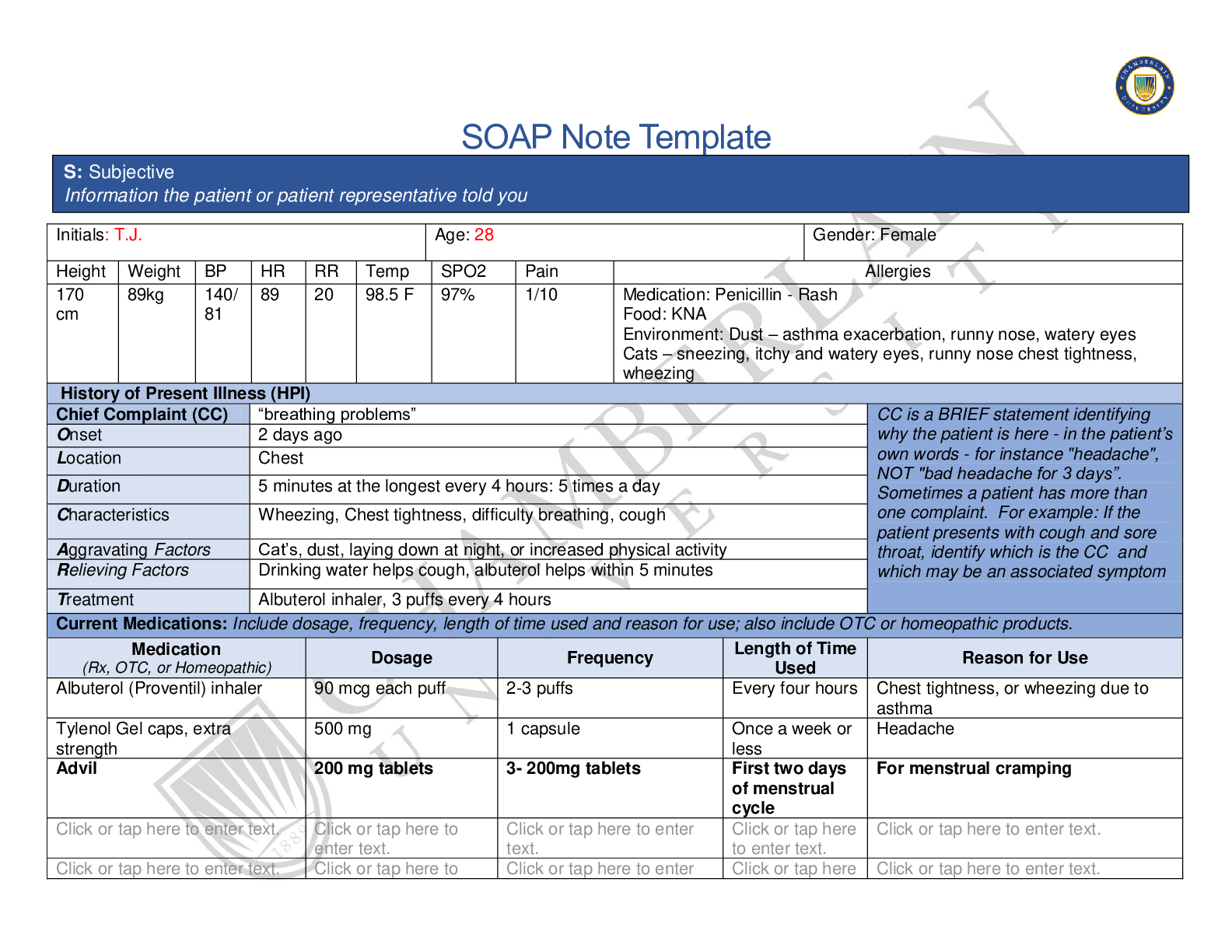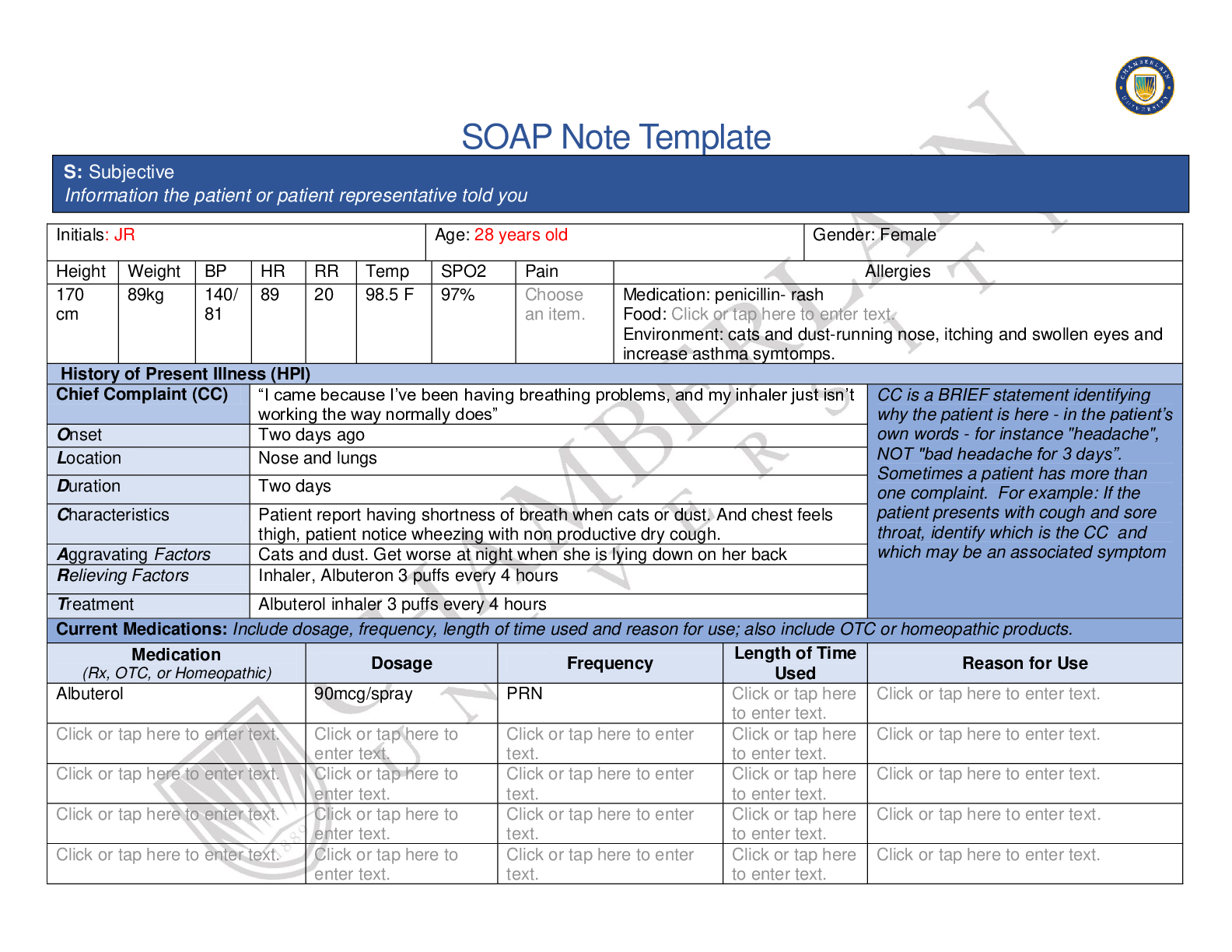*NURSING > EXAM > Chamberlain College of Nursing - NR 508/NR508 Midterm Question And Answers_Already Graded A. (All)
Chamberlain College of Nursing - NR 508/NR508 Midterm Question And Answers_Already Graded A.
Document Content and Description Below
NR 508-Pharmacology Mid-term Question 1 2 / 2 pts A patient has three consecutive blood pressure readings of 140/95 mm Hg. The patient’s body mass index is 24. A fasting plasma glucose is 100 mg/... dL. Creatinine clearance and cholesterol tests are normal. The primary care NP should order: a β-blocker. an angiotensin-converting enzyme inhibitor. a thiazide diuretic. dietary and lifestyle changes. The patient has stage I hypertension. Because there are no compelling indications for other treatment, a thiazide diuretic should be used initially to treat the hypertension. Dietary and lifestyle changes should also be recommended but are not sufficient for patients with stage I hypertension. Other drugs may be added later if thiazide diuretic therapy fails. Question 2 2 / 2 pts An African-American patient is taking captopril (Capoten) 25 mg twice daily. When performing a physical examination, the primary care nurse practitioner (NP) learns that the patient continues to have blood pressure readings of 135/90 mm Hg. The NP should: increase the captopril dose to 50 mg twice daily. add a thiazide diuretic to this patient’s regimen. change the drug to losartan (Cozaar) 50 mg once daily. recommend a low-sodium diet in addition to the medication. Some African-American patients do not appear to respond as well as whites in terms of blood pressure reduction. The addition of a low-dose thiazide diuretic often allows for efficacy in blood pressure lowering that is comparable with that seen in white patients. Increasing the captopril dose is not indicated. Losartan is an angiotensin receptor blocker (ARB) and is not indicated in this case. Question 3 2 / 2 pts A 50-year-old woman reports severe, frequent hot flashes and vaginal dryness. She is having irregular periods. She has no family history of CHD or breast cancer and has no personal risk factors. The primary care NP should recommend: estrogen-only HT. low-dose oral contraceptive therapy. selective serotonin reuptake inhibitor therapy until menopause begins. estrogen-progesterone HT. Oral contraceptive pills are not approved by the U.S. Food and Drug Administration for management of perimenopausal symptoms except to treat irregular menstrual bleeding. This patient has a low risk for CHD and breast cancer, so oral contraceptive pills are relatively safe. She is also at risk for pregnancy, so oral contraceptive pills can help to prevent that. Question 4 2 / 2 pts The primary care NP is prescribing a medication for an off-label use. To help prevent a medication error, the NP should: write “off-label use” on the prescription and provide a rationale. call the pharmacist to explain why the instructions deviate from common use. write the alternative drug regimen on the prescription and send it to the pharmacy. tell the patient to ignore the label directions and follow the verbal instructions given in the clinic. When prescribing a drug for an off-label use, the provider should specify this on the written prescription and should provide a rationale so that the pharmacist understands why the prescription is different from the normal use. Calling the pharmacist would not provide written documentation. Merely writing the different instructions can lead to errors if the pharmacist changes the label to conform to usual standards. The patient may forget verbal instructions and follow the usual regimen instead. Question 5 2 / 2 pts The primary care nurse practitioner (NP) sees a patient in the clinic who has a blood pressure of 130/85 mm Hg. The patient’s laboratory tests reveal high-density lipoprotein, 35 mg/dL; triglycerides, 120 mg/dL; and fasting plasma glucose, 100 mg/dL. The NP calculates a body mass index of 29. The patient has a positive family history for cardiovascular disease. The NP should: prescribe a thiazide diuretic. consider treatment with an angiotensin-converting enzyme inhibitor. reassure the patient that these findings are normal. counsel the patient about dietary and lifestyle changes. The patient’s blood pressure indicates prehypertension, but the patient does not have cardiovascular risk factors such as hyperlipidemia or hyperinsulinemia. The body mass index indicates that the patient is overweight but not obese. Pharmacologic treatment is not recommended for prehypertension unless compelling reasons are present. The findings are not normal, so it is appropriate to counsel the patient about diet and exercise. Question 6 2 / 2 pts A patient who has had a new onset of AF the day prior will undergo cardioversion that day. The primary care NP will expect the cardiologist to: give clopidogrel after administering cardioversion. administer cardioversion without using anticoagulants. give warfarin and aspirin before attempting cardioversion. give low-dose aspirin before administering cardioversion. If the onset of AF has occurred within 48 hours, cardioversion can be done without anticoagulation. Clopidogrel is used in other cases for patients who cannot take aspirin. For patients with rheumatic mitral valve disease and AF or a history of systemic embolism, cardioversion plus aspirin is used. Warfarin is used in patients with one or more risk factors for stroke. Question 7 2 / 2 pts A patient in the clinic reports frequent episodes of bloating, abdominal pain, and loose stools to the primary care nurse practitioner (NP). An important question the NP should ask about the abdominal pain is: the relation of the pain to stools. what time of day the pain occurs. whether the pain is sharp or diffuse. the age of the patient when the pain began. The new Rome II guidelines maintain that irritable bowel syndrome (IBS) of any subtype is characterized by a strong relationship between abdominal pain and defecation because of visceral hypersensitivity to gut-related events. The other characteristics of pain may be assessed to help guide management of IBS, but the first is necessary for a correct diagnosis. Question 8 2 / 2 pts A 55-year-old woman has a history of myocardial infarction (MI). A lipid profile reveals LDL of 130 mg/dL, HDL of 35 mg/dL, and triglycerides 150 mg/dL. The woman is sedentary with a body mass index of 26. The woman asks the primary care NP about using a statin medication. The NP should: recommend dietary and lifestyle changes first. begin therapy with atorvastatin 10 mg per day. discuss quality-of-life issues as part of the decision to begin medication. tell her there is no clinical evidence of efficacy of statin medication in her case. This woman would be using a statin medication for secondary prevention because she already has a history of MI, so a statin should be prescribed. Dietary and lifestyle changes should be a part of therapy, but not the only therapy. She is relatively young, and quality-of-life issues are not a concern. There is no clinical evidence to support use of statins as primary prevention in women. Question 9 2 / 2 pts A 2-year-old child has chronic “toddler’s” diarrhea, which has an unknown but benign etiology. The child’s parent asks the primary care NP if a medication can be used to treat the child’s symptoms. The NP should recommend giving: diphenoxylate (Lomotil). attapulgite (Kaopectate). an electrolyte solution (Pedialyte). bismuth subsalicylate (Pepto-Bismol). Antidiarrheals are not recommended in children. Opioids are contraindicated in children younger than 2 years. Bismuth and attapulgite are not recommended in children younger than 3 years of age. Oral rehydration with electrolyte solution is safe for young children. Question 10 2 / 2 pts A patient who has hyperlipidemia has been taking atorvastatin (Lipitor) 60 mg daily for 6 months. The patient’s initial lipid profile showed LDL of 180 mg/dL, HDL of 45 mg/dL, and triglycerides of 160 mg/dL. The primary care NP orders a lipid profile today that shows LDL of 105 mg/dL, HDL of 50 mg/dL, and triglycerides of 120 mg/dL. The patient reports muscle pain and weakness. The NP should: order liver function tests (LFTs). order a creatine kinase-MM (CK-MM) level. change atorvastatin to twice-daily dosing. add gemfibrozil (Lopid) to the patient’s medication regimen. Hepatotoxicity and muscle toxicity are the two primary adverse effects of greatest concern with statin use. Patients who report muscle discomfort or weakness should have a CK-MM level drawn. LFTs are indicated with signs of hepatotoxicity. It is not correct to change the dosing schedule. Gemfibrozil is not indicated. Question 11 2 / 2 pts A patient brings written information about a medication to a primary care NP about a new drug called Prism and wants to know if the NP will prescribe it. The NP notes that the information is from an internet site called “Prism.com.” The NP should tell this patient that: this information is probably from a drug advertisement website. this is factual, evidence-based material with accurate information. the information is from a nonprofit group that will not profit from drug sales. internet information is unreliable because anyone can post information there. Commercial internet sites are identifiable by “com” at the end of their web address. Many provide reliable information, but others may be more interested in selling something. Nonprofit groups use “org” at the end of their web addresses. Internet information is reliable as long as the internet user is aware of how things are posted and by whom. Question 12 2 / 2 pts A patient who is taking an ACE inhibitor sees the primary care NP for a follow-up visit. The patient reports having a persistent cough. The NP should: consider changing the medication to an ARB. order a bronchodilator to counter the bronchospasm caused by this drug. ask whether the patient has had any associated facial swelling with this cough. reassure the patient that tolerance to this adverse effect will develop over time. A persistent cough may occur with ACE inhibitors and may warrant discontinuation of the drug. An ARB would be the next drug of choice because it does not have this side effect. The cough is not related to bronchospasm. Angioedema is not related to ACE inhibitor–induced cough. Patients do not develop tolerance to this side effect. Question 13 2 / 2 pts A primary care NP is prescribing a drug for a patient who does not take any other medications. The NP should realize that: CYP450 enzyme reactions will not interfere with this drug’s metabolism. substrates such as alcohol cannot interfere with the drug when the patient is abstaining. food-drug interactions are limited to those where food enhances or inhibits drug absorption. a thorough history of diet, alcohol use, smoking, and over-the-counter and herbal products is required. Drugs are not the only substances that interfere with drug kinetics and dynamics. The primary care NP should conduct a thorough history of food and alcohol intake, smoking, and over-the-counter and herbal supplements to identify things that might interfere with a drug. All of these may interfere with CYP enzymes. Alcohol intake can influence this even when the patient is abstaining because of long-term effects on the liver. Question 14 2 / 2 pts A male patient tells the primary care NP he is experiencing decreased libido, lack of energy, and poor concentration. The NP performs an examination and notes increased body fat and gynecomastia. A serum testosterone level is 225 ng/dL. The NP’s next action should be to: order LH and FSH levels. order a serum prolactin level. prescribe testosterone replacement. obtain a morning serum testosterone level. To diagnose hypogonadism, two serum testosterone levels must be drawn, with serum collected in the morning. LH, FSH, and prolactin levels may be drawn as well. Testosterone replacement should not be prescribed until the diagnosis is definitive. Question 15 2 / 2 pts In every state, prescriptive authority for NPs includes the ability to write prescriptions: for controlled substances. for specified classifications of medications. without physician-mandated involvement. with full, independent prescriptive authority. All states now have some degree of prescriptive authority granted to NPs, but not all states allow authority to prescribe controlled substances. Many states still require some degree of physician involvement with certain types of drugs. Question 16 2 / 2 pts A patient who has an upper respiratory infection reports using over-the-counter cold preparations. The primary care NP should counsel this patient to use caution when taking additional over-the-counter medications such as: antipyretics. calcium supplements. acid reflux medications. antioxidant supplements. Cold preparations often contain antipyretics such as acetaminophen or aspirin. Patients should be cautioned about taking additional antipyretics to avoid overdose. Question 17 2 / 2 pts The primary care NP has referred a child who has significant gastrointestinal reflux disease to a specialist for consideration for a fundoplication and gastrostomy tube placement. The child’s weight is 80% of what is recommended for age, and a recent swallow study revealed significant risk for aspiration. The child’s parents do not want the procedure. The NP should: compromise with the parents and order a nasogastric tube for feedings. initiate a discussion with the parents about the potential outcomes of each possible action. refer the family to a case manager who can help guide the parents to the best decision. understand that the child’s parents have a right to make choices that override those of the medical team. In general, the goal of a health care decision maker is to choose an action that is most likely to deliver the outcomes the patient wants. Initiating a discussion about outcomes helps parents decide based on end results. A nasogastric tube is not the best choice for the child, and compromising without first exploring options is incorrect. As part of the therapeutic relationship, the NP should be involved with patients’ decisions. Although patients and families have the right to make decisions, the NP has an obligation to ensure that the decisions are informed decisions. Question 18 2 / 2 pts A patient who has experienced five to seven liquid stools for 3 days is seen in the clinic by the primary care NP. The patient reports having had fever, mucoid stools, and nausea without vomiting. The patient has been drinking Gatorade to stay hydrated. The NP obtains a stool specimen for culture and should prescribe: diphenoxylate (Lomotil). attapulgite (Kaopectate). bismuth subsalicylate (Pepto-Bismol). loperamide hydrochloride (Imodium). Bismuth reduces symptoms through antidiarrheal and antibacterial properties and can decrease nausea and vomiting. Opioid antidiarrheals should be given after the cause of infectious diarrhea is treated; these can actually prolong symptoms because they slow transit of the causative organisms through the gut. Attapulgite can be used because it binds bacteria and toxins in the gastrointestinal tract, but bismuth is a better choice in this case because it helps to treat nausea. The patient is drinking Gatorade and is getting electrolyte replacement. Question 19 2 / 2 pts A patient reports having occasional acute constipation with large, hard stools and pain and asks the primary care NP about medication to treat this condition. The NP learns that the patient drinks 1500 mL of water daily; eats fruits, vegetables, and bran; and exercises regularly. The NP should recommend: a daily bulk laxative. long-term docusate sodium. a saline laxative as needed. glycerin suppositories as needed. Mild short-term constipation may be treated with a saline laxative or a bulk laxative as needed. Daily laxatives are not recommended. Glycerin suppositories can cause irritation of the rectum with long-term use. Question 20 2 / 2 pts A postpartum woman will begin taking the minipill while she is nursing her infant. The primary care NP should instruct the patient: to use backup contraception while taking the minipill. to continue using the minipill for 6 months after she stops nursing. that irregular periods while taking the minipill may indicate she is pregnant. that this method does not increase her risk of thromboembolic events. Minipills are used primarily in breastfeeding women. There is no increased risk for thromboembolic events for women taking these pills. It is not necessary to use a backup method of contraception. Women should be advised to contact the provider when they stop nursing so that a COCP can be prescribed. The more disrupted the bleeding pattern, the more likely it is that ovulation is inhibited. Question 21 2 / 2 pts A patient comes to the clinic to discuss weight loss. The primary care NP notes a BMI of 32 and performs a health risk assessment that reveals no obesity-related risk factors. The NP should recommend: orlistat (Xenical). surgical intervention. changes in diet and exercise. changes in diet and exercise along with short-term phentermine. This patient is grade 2 overweight (obese), so a short-term course of phentermine is useful, especially as there are no cardiovascular risk factors. Orlistat is a second-line drug. Surgical intervention is indicated when other therapies fail. Changes in diet and physical activity alone do not bring immediate results, and patients often get discouraged. Question 22 2 / 2 pts A patient who has asthma and who is known to the primary care NP calls the NP after hours and asks for a refill of an albuterol metered-dose inhaler. The patient has not been seen in the clinic for more than a year. The NP should: call the pharmacy to order the medication with several refills. send an electronic prescription to the pharmacy for one time only. send the patient to the emergency department for evaluation of symptoms. refill the drug and tell the patient that an office visit is necessary for further refills. The patient needs the medication and is known to the NP so a refill is not inconsistent with practice guidelines. However, further refills should not be provided until the patient is seen and has an updated asthma action plan. The patient should be informed of this; simply refilling the prescription sends a message that it is acceptable to get refills without being seen. Question 23 2 / 2 pts A patient reports fatigue, weight loss, and dry skin. The primary care nurse practitioner (NP) orders thyroid function tests. The patient’s thyroid stimulating hormone (TSH) is 40 microunits/mL, and T4 is 0.1 ng/mL. The NP should refer the patient to an endocrinologist and prescribe: methimazole. liothyronine. levothyroxine. propylthiouracil. This patient has hypothyroidism and should be treated with levothyroxine. Methimazole is a thyroid suppressant. Liothyronine is synthetic T3. Propylthiouracil is a thyroid suppressant. Question 24 2 / 2 pts A patient who takes nitroglycerin for stable angina pectoris develops hypertension. The primary care NP should contact the patient’s cardiologist to discuss adding: amlodipine (Norvasc). diltiazem (Cardizem). verapamil HCl (Calan). nifedipine (Procardia XL). Nifedipine and related drugs are potent vasodilators, which makes them more effective for hypertension than verapamil and diltiazem. Amlodipine is not a first-line drug. Question 25 2 / 2 pts A primary care NP will begin practicing in a state in which the governor has opted out of the federal facility reimbursement requirement. The NP should be aware that this defines how NPs may write prescriptions: without physician supervision in private practice. as CRNAs without physician supervision in a hospital setting. in any situation but will not be reimbursed for this by government insurers. only with physician supervision in both private practice and a hospital setting. In 2001, the Centers for Medicare and Medicaid Services changed the federal physician supervision rule for CRNAs to allow state governors to opt out, allowing CRNAs to write prescriptions and dispense drugs without physician supervision. Question 26 2 / 2 pts A patient who has stable angina and uses sublingual nitroglycerin tablets is in the clinic and begins having chest pain. The primary care NP administers a nitroglycerin tablet and instructs the patient to lie down. The NP’s next action should be to: obtain an electrocardiogram. administer oxygen at 2 L/minute. give 325 mg of chewable aspirin. call EMS. When a patient experiences an acute attack of angina in the clinic, the primary care NP should be prepared to treat the condition. After giving nitroglycerin, oxygen should be administered. An electrocardiogram is not immediately indicated. Chewable aspirin is given if the angina is unrelieved and when the patient is being transported to the hospital. EMS should be activated if there is no pain relief 5 minutes after the first dose of nitroglycerin. Question 27 2 / 2 pts The primary care NP sees a new African-American patient who has blood pressure readings of 140/90 mm Hg, 130/85 mm Hg, and 142/80 mm Hg on three separate occasions. The NP learns that the patient has a family history of hypertension. The NP should: initiate monotherapy with a thiazide diuretic. prescribe a thiazide diuretic and an angiotensin-converting enzyme inhibitor. discuss dietary and lifestyle modifications with the patient. begin combination therapy with an ARB and a calcium-channel blocker. African Americans tend to respond better than whites to diuretic monotherapy, so this is an appropriate starting therapy. Calcium-channel blockers and ARBs are preferred as adjunct medications in African Americans. Question 28 2 / 2 pts A patient who has diabetes is taking simvastatin (Zocor) 80 mg daily to treat LDL cholesterol level of 170 mg/dL. The patient has a body mass index of 29. At a follow-up visit, the patient’s LDL level is 120 mg/dL. The primary care NP should consider: increasing the simvastatin to 80 mg twice daily. adding nicotinic acid to the patient’s drug regimen. changing the medication to ezetimibe/simvastatin (Vytorin). referring the patient to a dietitian for assistance with weight reduction. Patients with diabetes have a goal LDL of less than 100 mg/dL. If maximum-dose statin is unable to achieve the goal LDL, a combination product such as a statin plus ezetimibe is recommended. The maximum recommended dose is 80 mg daily, so increasing the dose to 80 mg twice daily is incorrect. Question 29 2 / 2 pts The primary care nurse practitioner (NP) writes a prescription for an antibiotic using an electronic drug prescription system. The pharmacist will fill this prescription when: the electronic prescription is received. the patient brings a written copy of the prescription. a copy of the written prescription is faxed to the pharmacy. the pharmacist accesses the patient’s electronic record to verify. E-sign effectively voids requirements that prescriptions be written on paper or printed as a hard copy. Some scheduled drugs still require written copies. Faxed copies of this drug would be allowed but are not necessary for the pharmacist to fill the prescription. The patient’s electronic medical record stands as evidence of the need for a prescription of a drug but is not needed for the pharmacist to fill the prescription. Question 30 2 / 2 pts A patient with a previous history of myocardial infarction (MI) who takes nitroglycerin for angina develops hypertension. The primary care NP is considering ordering an ACE inhibitor. Preliminary laboratory tests reveal decreased renal function. The NP should: begin therapy with a low-dose ACE inhibitor. choose an ARB instead. add a low-dose thiazide diuretic to the drug regimen. order a renal perfusion study before starting treatment. ACE inhibitors are contraindicated in patients with bilateral renal stenosis. Because this patient has decreased renal function, perfusion studies are indicated. If the patient does not have bilateral renal stenosis, a low-dose ACE inhibitor may be used. An ARB is indicated if perfusion studies show bilateral renal stenosis. A thiazide diuretic is not indicated. Question 31 2 / 2 pts A woman who is taking a progestin-only pill has just stopped nursing her 9-month-old infant and tells the primary care NP that she would like to space her children about 2 years apart. The NP should: discontinue the progestin-only pill. prescribe a COCP and a folic acid supplement. prescribe a progestin-only pill for another 6 months. suggest that she use a barrier method of contraception. Serum folate levels may be decreased by oral contraceptives. Women who become pregnant shortly after stopping oral contraceptive use may have a greater chance of birth defects. This woman should become pregnant in about 6 months if she wants to space her children 2 years apart, so she needs an oral contraceptive. Progestin-only pills are used only during lactation. Question 32 2 / 2 pts A primary care NP is aware that many patients in the community use herbal remedies to treat various conditions. The NP understands the importance of: learning about the actions, uses, doses, and toxicities of these agents. prescribing these agents when possible to ensure safe dosing. counseling patients to stop using herbal products to avoid toxic side effects. teaching patients that these products are unregulated and unsafe to use. It is important for primary care providers to be familiar with these products and their ingredients so that they can help patients choose the safest product for their ailments. Because there are few evidence-based recommendations for the use of these products, NPs should not prescribe them. Counseling patients to stop using the products would probably not be effective; it is more important to know about the products to assist patients in decision making. Although it is true that the products are not directly regulated by the Food and Drug Administration (FDA), there are agencies that maintain safety of the products. Question 33 2 / 2 pts A patient who has a history of chronic constipation uses a bulk laxative to prevent episodes of acute constipation. The patient reports having an increased frequency of episodes. The primary care NP should recommend: adding docusate sodium (Colace). polyethylene glycol (MiraLAX) and bisacodyl (Dulcolax). lactulose (Chronulac) and polyethylene glycol (MiraLAX). adding nonpharmacologic measures such as biofeedback. Patients treated for long-term constipation should begin with a bulk laxative. If that is not effective, the addition of a second laxative may be necessary. Using two laxatives from the same category is not recommended. A stool softener, such as docusate sodium, is appropriate. Bisacodyl is not a second-line treatment. Lactulose and polyethylene glycol are from the same category. Question 34 2 / 2 pts A 5-year-old child has chronic constipation. The primary care NP plans to prescribe a laxative for long-term management. In addition to pharmacologic therapy, the NP should also recommend _____ g of fiber per day. 10 15 20 25 Each day a child should receive 1 g of fiber per year of age plus 5 g after 2 years of age. Question 35 2 / 2 pts A patient who has breast cancer has been taking toremifene for 2 weeks. She tells her primary care NP that she thinks her tumor has grown larger. The NP should: schedule her for a breast ultrasound. reassure her that this is common and will subside. tell her she may need an increased dose of this medication. contact her oncologist to discuss adding another medication. Toremifene can cause tumor flare in the first few weeks of therapy, but the tumor later regresses. An ultrasound is unnecessary at this stage. The NP does not need to notify the oncologist unless this continues to worsen. Question 36 0 / 2 pts A patient is given a diagnosis of peptic ulcer disease. A laboratory test confirms the presence of Helicobacter pylori. The primary care NP orders a proton pump inhibitor (PPI) before meals twice daily, clarithromycin, and amoxicillin. After 14 days of treatment, H. pylori is still present. The NP should order: continuation of the PPI for 4 to 8 weeks. Correct Answer a PPI, amoxicillin, and metronidazole for 14 days. a PPI, clarithromycin, and amoxicillin for 14 more days. You Answered a PPI, bismuth subsalicylate, tetracycline, and metronidazole. A PPI, along with amoxicillin and metronidazole, is used as first-line treatment in macrolide-allergic patients and for re-treatment for 14 days if first-line treatment of choice failed because of occasional resistance to clarithromycin. Question 37 2 / 2 pts A patient who has angina uses 0.4 mg of sublingual nitroglycerin for angina episodes. The patient brings a log of angina episodes to an annual physical examination. The primary care NP notes that the patient has experienced an increase in frequency of episodes in the past month but no increase in duration or severity of pain. The NP should: increase the nitroglycerin dose to 0.6 mg per dose. change from a sublingual to a transdermal patch nitroglycerin. discontinue the nitroglycerin and order ranolazine (Ranexa ER). contact the patient’s cardiologist to discuss admission to the hospital. Unstable angina is a change in pattern or pain, such as an increase in frequency, severity, or duration of pain and fewer precipitating factors. Patients with unstable angina should be admitted to a coronary care unit. The primary care NP should not change any medications without consultation with the patient’s cardiologist. Question 38 2 / 2 pts A patient comes to the clinic reporting dizziness and fatigue associated with nausea and vomiting. The primary care NP suspects anemia and orders a complete blood count. The patient’s hemoglobin is elevated. The NP correctly concludes that the patient is not anemic. The NP has made an error in: context formulation. inappropriate knowledge base. cost-versus-benefit analysis. hypothesis triggering and information processing. Faulty hypothesis triggering occurs when the clinician fails to consider appropriate initial hypotheses. The patient had nausea and vomiting, which can cause dehydration, leading to orthostatic hypotension and dizziness. The NP made an assumption that the dizziness was caused by anemia and ordered a complete blood count. Faulty information gathering occurs when clinicians fail to order appropriate tests. An error in context formulation occurs when clinicians and patients have different goals. Errors in knowledge base would occur if the practitioner did not perform a complete history and physical, missing important information. An error in cost-versus-benefit analysis could occur if the clinician ordered expensive tests that were not necessary for diagnosis and treatment. Question 39 2 / 2 pts A patient with type 2 diabetes mellitus takes metformin (Glucophage) 1000 mg twice daily and glyburide (Micronase) 12 mg daily. At an annual physical examination, the BMI is 29 and hemoglobin A1c is 7.3%. The NP should: begin insulin therapy. change to therapy with colesevelam (Welchol). add a third oral antidiabetic agent to this patient’s drug regimen. enroll the patient in a weight loss program to achieve better glycemic control. The target hemoglobin A1c goal for adults is less than 7%. Insulin therapy is indicated if maximum doses of two oral antidiabetic drugs are not effective. This patient is taking the maximum recommended doses of metformin and glyburide. Colesevelam does not decrease hemoglobin A1c. Adding a third oral antidiabetic agent is not recommended. A weight loss program may be a part of this patient’s treatment, but insulin is necessary to maintain glycemic control. Question 40 2 / 2 pts A patient who has a history of angina has sublingual nitroglycerin tablets to use as needed. The primary care nurse practitioner (NP) reviews this medication with the patient at the patient’s annual physical examination. Which statement by the patient indicates understanding of the medication? “I should call 9-1-1 if chest pain persists 5 minutes after the first dose.” “I should take 3 nitroglycerin tablets 5 minutes apart and then call 9-1-1.” “I should take aspirin along with the nitroglycerin when I have chest pain.” “I should take nitroglycerin and then rest for 15 minutes before taking the next dose.” Although the traditional recommendation is for patients to take up to 3 nitroglycerin doses over 15 minutes before accessing emergency medical services (EMS), more recent guidelines suggest an alternative strategy to reduce delays in emergency care. These include instructions to call 9-1-1 immediately if pain persists for 5 minutes after the first dose. Aspirin is recommended when the patient is being transported to emergency care and is not recommended as an adjunct to nitroglycerin with each episode of chest pain. The three doses of nitroglycerin are given 5 minutes apart over 15 minutes. Question 41 2 / 2 pts The primary care nurse practitioner (NP) sees a patient for a physical examination and orders laboratory tests that reveal low-density lipoprotein (LDL) of 100 mg/dL, high-density lipoprotein (HDL) of 30 mg/dL, and triglycerides of 350 mg/dL. The patient has no previous history of coronary heart disease. The NP should consider prescribing: ezetimibe (Zetia). gemfibrozil (Lopid). simvastatin (Zocor). nicotinic acid (Niaspan). Fibric acid derivatives, such as gemfibrozil, are indicated for reducing the risk that coronary heart disease may develop in patients without a history of coronary heart disease who have low HDL cholesterol levels and elevated triglyceride levels. This patient’s LDL is within normal limits, so a 3-hydroxy-3-methylglutaryl coenzyme A (HMG-CoA) reductase inhibitor, such as simvastatin, is not indicated. Ezetimibe is a selective cholesterol absorption inhibitor, used to reduce total and LDL cholesterol. Nicotinic acid is used to treat hyperlipidemia in patients who have failed dietary therapy. Question 42 2 / 2 pts A primary care NP sees a 5-year-old child who is morbidly obese. The child has an elevated hemoglobin A1c and increased lipid levels. Both of the child’s parents are overweight but not obese, and they tell the NP that they see nothing wrong with their child. They both state that it is difficult to refuse their child’s requests for soda or ice cream. The NP should: suggest that they give the child diet soda and low-fat frozen yogurt. understand and respect the parents’ beliefs about their child’s self-image. initiate a dialogue with the parents about the implications of the child’s laboratory values. suggest family counseling to explore ways to improve parenting skills and limits. In this case, the child is at risk if the parents do not intervene. The NP should help the parents to see the potential adverse effects so that they can understand the need for treatment. The other answers are examples of the NP creating solutions. Unless the parents see the problem, they are not likely to engage in the treatment regimen. Question 43 2 / 2 pts The primary care NP sees a new patient who has diabetes and hypertension and has been taking a thiazide diuretic for 6 months. The patient’s blood pressure at the beginning of treatment was 150/95 mm Hg. The blood pressure today is 138/85 mm Hg. The NP should: order a β-blocker. add an angiotensin-converting enzyme inhibitor. continue the current drug regimen. change to an aldosterone antagonist medication. Evidence-based guidelines suggest that optimal control of hypertension to less than 130/80 mm Hg could prevent 37% of cardiovascular disease in men and 56% in women, so this patient, although showing improvement, could benefit from the addition of another medication. An angiotensin-converting enzyme inhibitor is an appropriate drug for patients who also have diabetes. β-Blockers and aldosterone antagonist medications are not recommended for patients with diabetes. Question 44 2 / 2 pts The primary care NP is considering prescribing captopril (Capoten) for a patient. The NP learns that the patient has decreased renal function and has renal artery stenosis in the right kidney. The NP should: initiate ACE inhibitor therapy at a low dose. consider a different drug class to treat this patient’s symptoms. give the captopril with a thiazide diuretic to improve renal function. order lisinopril (Zestril) instead of captopril to avoid increased nephropathy. Patients with impaired renal function should use low-dose ACE inhibitors. It is not necessary to avoid ACE inhibitors with unilateral renal stenosis. Question 45 2 / 2 pts A 40-year-old patient is in the clinic for a routine physical examination. The patient has a body mass index (BMI) of 26. The patient is active and walks a dog daily. A lipid profile reveals low-density lipoprotein (LDL) of 100 mg/dL, high-density lipoprotein (HDL) of 30 mg/dL, and triglycerides of 250 mg/dL. The primary care nurse practitioner (NP) should: order a fasting plasma glucose level. consider prescribing metformin (Glucophage). suggest dietary changes and increased exercise. obtain serum insulin and hemoglobin A1c levels. Testing for type 2 diabetes should be considered in all adults with a BMI greater than 25 who have risk factors such as HDL less than 35 mg/dL or triglycerides greater than 250 mg/dL. A fasting plasma glucose level greater than 126 mg/dL indicates diabetes. Metformin is not indicated unless testing is positive. Lifestyle changes may be part of the treatment plan. Serum insulin level is not indicated. Question 46 2 / 2 pts An African-American patient who is obese has persistent blood pressure readings greater than 150/95 mm Hg despite treatment with a thiazide diuretic. The primary care NP should consider prescribing a(n): angiotensin receptor blocker. β-blocker. ACE inhibitor. calcium channel blocker. African-American patients are considered good candidates for calcium channel blockers to treat hypertension. Treatment with calcium channel blockers as monotherapy in African-American patients has proved to be more effective than some other classes of antihypertensive agents. Question 47 2 / 2 pts A primary care NP sees a 3-year-old patient who has been vomiting for several days. The child has had fewer episodes of vomiting the past day and is now able to take sips of fluids without vomiting. The child has dry oral mucous membranes, 2-second capillary refill, and pale but warm skin. The child’s blood pressure is 88/46 mm Hg, the heart rate is 110 beats per minute, and the temperature is 37.2° C. The NP should: prescribe promethazine. prescribe a scopolamine patch. begin oral rehydration therapy. send the child to the hospital for IV fluids. The use of antiemetics in children is discouraged for cases of uncomplicated vomiting. The child has compensated, mild dehydration and is now able to tolerate fluids, so oral rehydration is indicated. Question 48 2 / 2 pts A woman comes to the clinic to talk about weight reduction. The primary care nurse practitioner (NP) calculates a body mass index (BMI) of 28. The woman’s waist measures 34 inches. The woman tells the NP that she would like to lose 20 lb for her daughter’s wedding in 6 months. The NP should: suggest she try over-the-counter (OTC) orlistat. consider prescribing phentermine short-term. discuss her short-term and long-term weight loss goals. give her information about physical activity and diet modification. This woman’s BMI is in the moderate range for overweight, and her waist circumference is 34, which is not diagnostic for metabolic syndrome. Because her apparent motivation for losing weight is based on an upcoming event, the NP first should determine what her short-term and long-term weight loss goals are before initiating therapy. Orlistat is used long-term and would not be appropriate in this case. Phentermine should be used short-term and, because of serious risks, should be used only as adjunct therapy to lifestyle modifications. The initial intervention for weight loss is physical activity and diet modification. Question 49 2 / 2 pts A patient who has diabetes is taking metformin 1000 mg daily. At a clinic visit, the patient reports having abdominal pain and nausea. The primary care NP notes a heart rate of 92 beats per minute. The NP should: obtain LFTs. decrease the dose of metformin. change metformin to glyburide. order electrolytes, ketones, and serum glucose. Symptoms of lactic acidosis include nausea, abdominal pain, and tachycardia. Tests should include electrolytes, ketones, and serum glucose. Question 50 2 / 2 pts A patient reports having episodes of dizziness, nausea, and lightheadedness and describes a sensation of the room spinning when these occur. The primary care NP will refer the patient to a specialist who, after diagnostic testing, is likely to prescribe: meclizine. ondansetron. scopolamine. dimenhydrinate. Patients with vertigo may experience whirling or a feeling of the room spinning around. In true vertigo, the patient can identify the direction in which the room is spinning. Anticholinergics are the most effective agents in cases of motion sickness or vertigo. Meclizine has a specific indication to treat vertigo. Question 51 2 / 2 pts Which of the following has influenced an emphasis on primary care education in medical schools? Changes in Medicare reimbursement methods recommended in 1992 Competition from nonphysicians desiring to meet primary care shortages The need for monopolistic control in the marketplace of primary outpatient care The recognition that nonphysicians have variable success providing primary care The Physician Payment Review Commission in 1992 directly increased financial reimbursement to clinicians who provide primary care. Coupled with a shortage of primary care providers, this incentive led medical schools to place greater emphasis on preparing primary care physicians. Competition from nonphysicians increased coincidentally as professionals from other disciplines stepped up to meet the needs. Nonphysicians have had increasing success at providing primary care and have been shown to be safe and effective. Question 52 2 / 2 pts A patient who has GERD with erosive esophagitis has been taking a PPI for 4 weeks and reports a decrease in symptoms. The patient asks the primary care NP if the medication may be discontinued. The NP should tell the patient that: the dose may be decreased for long-term therapy. antireflux surgery must be done before the PPI can be discontinued. the condition may eventually be cured, but therapy must continue for years. once the symptoms have cleared completely, the medication may be discontinued. Once PPIs have proven clinically effective for treatment of patients with esophagitis, therapy should be continued long-term and titrated down to the lowest effective dose based on symptom control. PPI therapy is considered safer than surgery and should be tried first before surgery is performed. GERD is a lifelong syndrome and is not curable. Question 53 2 / 2 pts A patient comes to the clinic with a 2-day history of cough and wheezing. The patient has no previous history of asthma. The patient reports having heartburn for several months, which has worsened considerably. The primary care NP makes a diagnosis of asthma and orders oral steroids and inhaled albuterol. The patient’s condition worsens, and a chest radiograph obtained 2 days later shows bilateral infiltrates. The NP has failed to: confirm the diagnosis. determine the aggressiveness of therapy. prescribe an adequate dose of medications. allow the drugs an adequate amount of time to work. This patient had symptoms that could occur with both asthma and aspiration pneumonia. The NP failed to confirm the diagnosis and prescribed the wrong treatment, leading to worsening of symptoms. Question 54 2 / 2 pts A patient who has been taking propranolol for 6 months reports having nocturnal cough and shortness of breath. The primary care NP should: tell the patient to stop taking the medication. obtain serum drug levels to monitor for toxicity of this medication. instruct the patient to increase activity and exercise to counter these side effects. contact the patient’s cardiologist to discuss changing to a selective β-blocker. Nocturnal cough and shortness of breath may be a side effect of propranolol, which can cause bronchospasm because it is a nonselective â-blocker. The NP should discuss a selective β-blocker with the patient’s cardiologist. â-Blockers should never be stopped abruptly. Bradycardia and hypotension are signs of toxicity. Increasing activity would not counter these side effects if bronchospasm is the cause. Question 55 2 / 2 pts A primary care nurse practitioner (NP) prescribes a drug to an 80-year-old African-American woman. When selecting a drug and determining the correct dose, the NP should understand that the knowledge of how age, race, and gender may affect drug excretion is based on an understanding of: bioavailability. pharmacokinetics. pharmacodynamics. anatomy and physiology. Pharmacokinetics is the study of the action of drugs in the body and may be thought of as what the body does to the drug. Factors such as age, race, and gender may change the way the body acts to metabolize and excrete a drug. Bioavailability refers to the amount of drug available at the site of action. Pharmacodynamics is the study of the effects of drugs on the body. Anatomy and physiology is a basic understanding of how the body functions. Question 56 2 / 2 pts A patient takes a cardiac medication that has a very narrow therapeutic range. The primary care NP learns that the particular brand the patient is taking is no longer covered by the patient’s medical plan. The NP knows that the bioavailability of the drug varies from brand to brand. The NP should: contact the insurance provider to explain why this particular formulation is necessary. change the patient’s medication to a different drug class that doesn’t have these bioavailability variations. accept the situation and monitor the patient closely for drug effects with each prescription refill. ask the pharmaceutical company that makes the drug for samples so that the patient does not incur out-of-pocket expense. In this case, the NP should advocate for the desired drug because changing the drug can have life-threatening consequences. If this fails, other options may have to be explored. Question 57 2 / 2 pts A primary care nurse practitioner (NP) sees a patient who is concerned about constipation. The NP learns that the patient has three to four bowel movements per week with occasional hard stools but no straining with defecation. The NP should recommend: increased intake of fluids and fiber. docusate sodium (Colace) as needed. psyllium (Metamucil) on a daily basis. polyethylene glycol (MiraLAX) as needed. The objective definition of constipation is two or fewer bowel movements per week or excessive straining. This patient does not meet these criteria, so the NP should recommend increasing fluids and fiber to help soften stools. Laxatives should not be used unless constipation is present or is chronic to avoid laxative dependence. Question 58 2 / 2 pts A postmenopausal woman develops NSAID-induced ulcer. The primary care NP should prescribe: ranitidine (Zantac). omeprazole (Prilosec). esomeprazole (Nexium). pantoprazole (Protonix). PPIs carry a possible increased risk of fractures in postmenopausal women. The NP should begin therapy with a histamine-2 blocker, such as ranitidine. Question 59 2 / 2 pts A patient comes to the clinic with a history of syncope and weakness for 2 to 3 days. The primary care NP notes thready, rapid pulses and 3-second capillary refill. An ECG reveals a heart rate of 198 beats per minute with a regular rhythm. The NP should: administer intravenous fluids and obtain serum electrolytes. administer amiodarone in the clinic and observe closely for response. order digoxin and verapamil and ask the patient to return for a follow-up examination in 1 week. send the patient to an emergency department for evaluation and treatment. Paroxysmal supraventricular tachycardia (PSVT) is a very fast regular rate and rhythm. This patient is becoming decompensated and should be referred to the emergency department for evaluation and treatment. The primary care NP should not treat this in the clinic or as an outpatient until the patient is stable. Question 60 2 / 2 pts A primary care NP sees a patient who is about to take a cruise and reports having had motion sickness with nausea on a previous cruise. The NP prescribes the scopolamine transdermal patch and should instruct the patient to apply the patch: daily. every 3 days. as needed for nausea. 1 hour before embarking. The transdermal system allows steady-state plasma levels of scopolamine to be reached rapidly and maintained for 3 days. The onset of action is approximately 4 hours. The patch should be changed every 3 days and left on at all times, not as needed. [Show More]
Last updated: 1 year ago
Preview 1 out of 46 pages

Reviews( 0 )
Document information
Connected school, study & course
About the document
Uploaded On
Aug 27, 2020
Number of pages
46
Written in
Additional information
This document has been written for:
Uploaded
Aug 27, 2020
Downloads
0
Views
49


